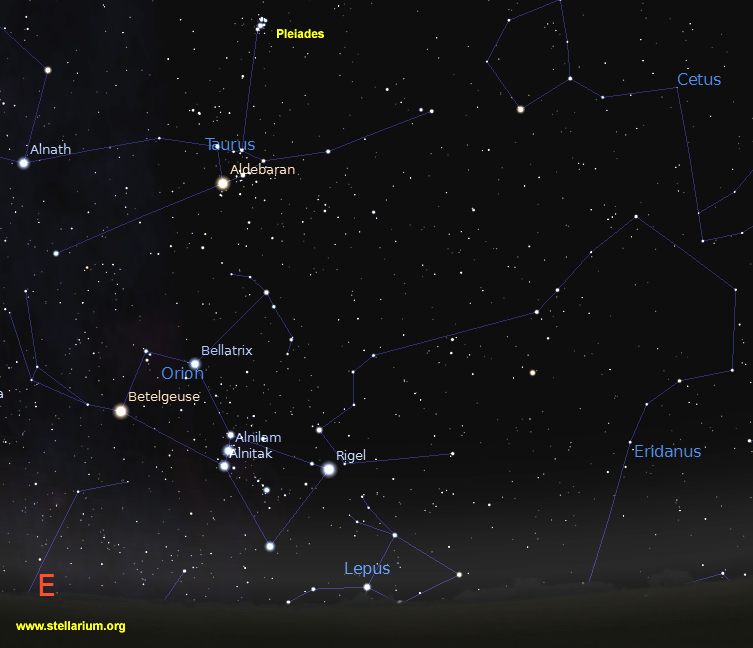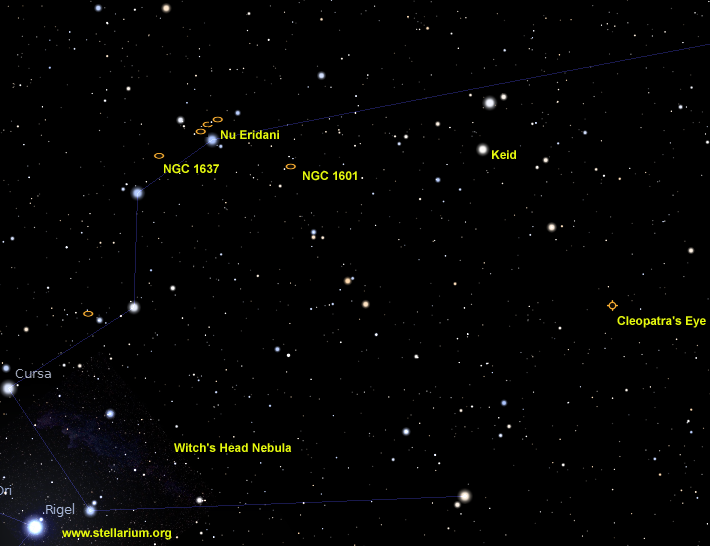Long Winter Nights
Winter’s brighter stars are coming into sight earlier each evening. By 8 p.m. local time at the beginning of this month, Orion is nicely perched in the eastern horizon. Moving vertically we see his combatant – Taurus the Bull with the bright star Aldebaran (its eye). Still higher in the sky is a small but easily recognized cluster of stars called the Pleiades or The Seven Sisters. Amongst the 200 of so stars that make up the 450 light-year distant cluster, seven are seen with the unaided eye and a great test for how good are sky conditions. These three make a great photo opportunity.
To the right of Orion is a long chain of stars that eventually disappears past the southern horizon. In fact the constellation end at -57 degrees south with the right star named Achernar that rivals Procyon in brightness at magnitude 0.5. Eridanus is listed as the 6th largest area in the sky and is home to many celestial objects.

We will start off with a large, faint reflection nebula called the Witch Head Nebula catalogued as IC 2118. It is located two and a half degrees west of Rigel – the bottom right of the famous hunter, Orion. Rigel is a blue supergiant star located 770 light-years (ly) from the earth with its light equivalent to 40,000 times that of our Sun. This is the celestial lighthouse that is illuminating the IC 2118. But this 1000 ly distant patch of faint gas and dust can only be seen visually under very dark conditions along with a large scope. With its great dimensions of six lunar diameters long by two diameters wide, it does make a great wide-angle photographic challenge.
Next is the planetary nebula named Cleopatra’s Eye or NGC 1535. Appearing somewhat like the Eskimo nebula, this planetary nebula appears as a magnitude 9.5 patch of light, aqua in colour with a central dot that stands out. It is a must-see on your observing list. Moving ten degrees to the west of Rigel and six degrees north, you will come across a nice trio of elongated galaxies. NGC 1625, 1622 and 1618 can be found by first locating magnitude 4.1 Nu Eridani. At magnitudes 12.4, 12.3 and 12.6 respectively, they are about 11 arc seconds north the east of this bright star.
The multiple star system named Keid is quite interesting as it is a classic example of a white dwarf. At a distance of only 16 light-years away, Keid also known as Keid A has two dwarf stars close by namely the B and C components, are white and red in colour and are quite close together. Power is essential. This star system is also known as Omicron 2 or 40 Eridani.

As for the planets, Saturn is lost in the solar glare after sunset and will be in conjunction with the Sun on the 10th. Venus, on the other hand, is higher in the western sky and at magnitude -3.6, is extremely easy to find. It continues to pull away from the Sun until its greatest elongation on January 12. Mars is still visible at magnitude 0.8 during the early evening but is getting progressively fainter and be at magnitude 1.0 at the end of the month. Jupiter rises just after 3 a.m. local time on Dec 1. Be sure to follow the shadows and transits of the Jovian moons located on page 236 of the RASC Observer’s Handbook 2016.
The winter solstice officially occurs on December 21 at 10:44 UT. The full Cold or Long night moon occurs on December 13 at 19:06 p.m. eastern which is just in time to block out some of the Geminid meteor shower which peaks the same night. The parent to this shower is asteroid 3200 Phaethon and delivered about 120 meteors per hour under good conditions. Eight night later will be the peak of the Ursid meteor shower which only produces about 10 meteors per hour. The new moon occurs on December 29 at 6:53 UT.
Until next month, clear skies everyone.
Twitter: @astroeducator
